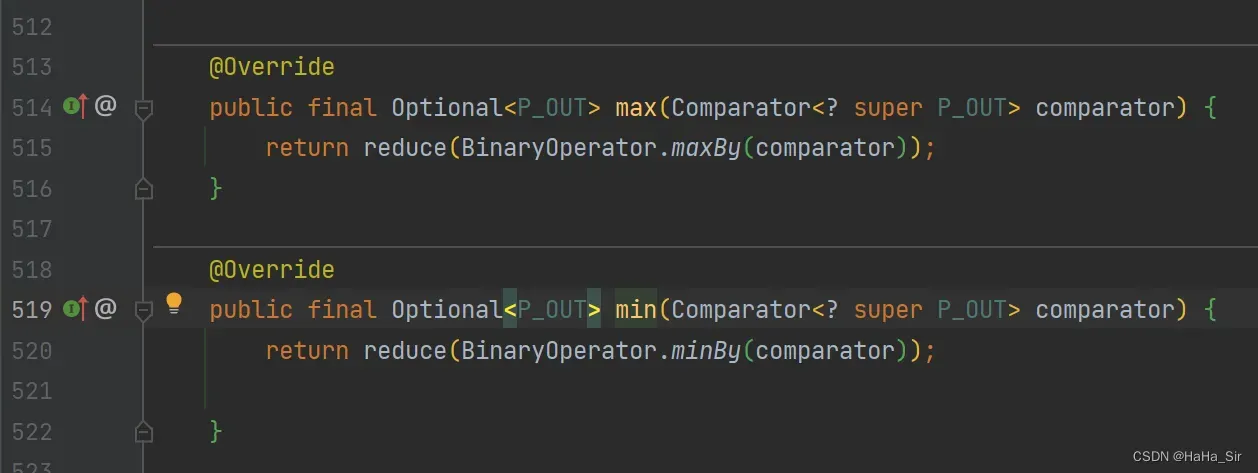java8 stream reduce 方法用法 java stream reduce 方法使用方法
一、背景
在使用Stream的reduce方法时,发现该方法有 3个重载方法,分别是: 一个参数、两个参数、三个参数的,那么这3个重载方法的区别和用法呢, 本文将研究3个重载方法之间的区别,理清 一个参数、两个参数、三个参数 的使用场景。
// 一个参数
Optional<T> reduce(BinaryOperator<T> accumulator);
// 两个参数
T reduce(T identity, BinaryOperator<T> accumulator);
// 三个参数
<U> U reduce(U identity,
BiFunction<U, ? super T, U> accumulator,
BinaryOperator<U> combiner);二、相关功能接口理解
1、BiFunction 接口 :
可以看到输入2个参数,输出一个参数
@FunctionalInterface
public interface BiFunction<T, U, R> {
R apply(T t, U u);
}2、BinaryOperator 接口:
具备BiFunction 接口功能,还有2个静态方法 minBy 和 maxBy ,看方法名称作用是:获取最大值和最小值
@FunctionalInterface
public interface BinaryOperator<T> extends BiFunction<T,T,T> {
public static <T> BinaryOperator<T> minBy(Comparator<? super T> comparator) {
Objects.requireNonNull(comparator);
return (a, b) -> comparator.compare(a, b) <= 0 ? a : b;
}
public static <T> BinaryOperator<T> maxBy(Comparator<? super T> comparator) {
Objects.requireNonNull(comparator);
return (a, b) -> comparator.compare(a, b) >= 0 ? a : b;
}
}三、stream reduce 方法代码示例
1、reduce 方法,一个参数:
主要作用 累加、累减,求取最大值、最小值。
@Test
public void streamReduceOneTest() throws Exception{
final ArrayList<Integer> list = Lists.newArrayList(1, 3, 5, 2, 4);
// 累加, 1+3+5+2+4
final Optional<Integer> reduce = list.stream().reduce((x, y) -> x + y);
// 累减, 1-3-5-2-4
final Optional<Integer> reduce2 = list.stream().reduce((x, y) -> x - y);
System.out.println("reduce x+y ==>" + reduce.orElse(null));
System.out.println("reduce2 x-y ==>" + reduce2.orElse(null));
// BigDecimal 类型,累加求和
final Optional<BigDecimal> reduce1 = list.stream().map(BigDecimal::new).reduce(BigDecimal::add);
System.out.println("BigDecimal add : "+ reduce1.get());
// 求取 最大值、最小值
final Optional<Integer> reduce3 = list.stream().reduce(BinaryOperator.maxBy((x, y) -> x - y));
final Optional<Integer> reduce4 = list.stream().reduce(BinaryOperator.maxBy((x, y) -> y - x));
System.out.println("max : " + reduce3.get());
System.out.println("min : " + reduce4.get());
}1.1、reduce 方法,一个参数,输出结果:
reduce x+y ==>15
reduce2 x-y ==>-13
BigDecimal add : 15
max : 5
min : 1
2、reduce 方法,两个参数
主要作用,多了一个初始值,功能同一个参数的
@Test
public void streamReduceTwoTest() throws Exception {
final ArrayList<Integer> list = Lists.newArrayList(1, 3, 5, 2, 4);
// 2个参数,初始化10,一起累加 , 10+1+3+5+2+4
final Integer reduce = list.stream().reduce(10, (x, y) -> x + y);
// 2个参数,初始化10,一起累减 , 10-1-3-5-2-4
final Integer reduce2 = list.stream().reduce(10, (x, y) -> x - y);
System.out.println("初始化10,reduce x+y ==>" + reduce);
System.out.println("初始化10,reduce2 x-y ==>" + reduce2);
// 累乘, 10*1*3*5*2*4
final Integer reduce1 = list.stream().reduce(10, (x, y) -> x * y);
System.out.println("累积乘法 reduce1 ::: " + reduce1);
// 最大值
final Integer reduce3 = list.stream().reduce(10, BinaryOperator.maxBy((x, y) -> x - y));
System.out.println("最大值: " +reduce3);
}2.1、reduce 方法,两个参数,输出结果:
初始化10,reduce x+y ==>25
初始化10,reduce2 x-y ==>-5
累积乘法 reduce1 ::: 1200
最大值: 103、reduce 方法,三个参数:
@Test
public void streamReduceThreeTest() throws Exception {
final ArrayList<Integer> list = Lists.newArrayList(1, 3, 5, 2, 4);
final Integer reduce = list.stream().reduce(20, (x, y) -> x + y, (t, r) -> t - r);
System.out.println("reduce 3个参数:"+reduce);
final ArrayList<String> strList = Lists.newArrayList("aa", "bb", "cc");
// 字符串拼接处理:
/**
* (x, y) -> x.concat(";").concat(y):
* x:初始化 identity 参数 ,
* y: 集合中的每一个元素
*/
final String reduce_three_arg = strList.stream().reduce(String.valueOf("reduce three arg: "), (x, y) -> x.concat(";").concat(y), (x, y) -> x);
System.out.println("reduce 3个参数 22:"+reduce_three_arg);
final String reduce_three_arg2 = strList.stream().reduce(String.valueOf(""), (x, y) -> x.concat(";").concat(y), (x, y) -> x);
System.out.println("reduce 3个参数 2222:"+reduce_three_arg2);
}3.1、reduce 方法,三个参数,输出结果:
reduce 3个参数:35
reduce 3个参数 22:reduce three arg: ;aa;bb;cc
reduce 3个参数 2222:;aa;bb;cc
3.2、可以看到 reduce 在3个参数情况下,第三个参数 BinaryOperator<U> combiner , 貌似是没啥作用的 … 其实reduce方法三个参数在 并行流 情况下,才会有用 …
4、reduce 方法,三个参数 parallel 并行流
@Test
public void streamReduceThreeParallelTest() throws Exception {
final List<Integer> list = Lists.newArrayList(1, 2, 3, 4, 5);
final Integer reduce = list.stream().reduce(0, (x, y) -> x + y, (x, y) -> x * y);
System.out.println(reduce);
// 使用 并行流
final Integer reduce2 = list.parallelStream().reduce(0, (x, y) -> x + y, (x, y) -> x * y);
System.out.println(reduce2);
final Integer reduce3 = list.stream().parallel().reduce(0, (x, y) -> x + y, (x, y) -> x * y);
System.out.println(reduce3);
}
4.1、输出结果:
15
120
120
5四、总结
1、reduce 方法:多个数据,合并为一个数据;主要功能如下:
- 累积计算,加减乘除等运算,字符串拼接
- 获取最值,最大值,最小值
2、Sream.max 和 Sream.min 实际调用的就是 reduce 方法

3、reduce 方法3个参数之间的区别
- 一个参数:多个数据,合并为一个数据
- 两个参数:比一个参数,多一个identity初始化数据
- 三个参数:并行流的情况下:第三个参数有用,第二个参数没用;非并行流反之 …
遗留问题:reduce 方法3个参数,实际应用场景不确定。并行流,第二个参数失效,非并行流,第三个参数失效的原因 ..
文章出处登录后可见!
已经登录?立即刷新
